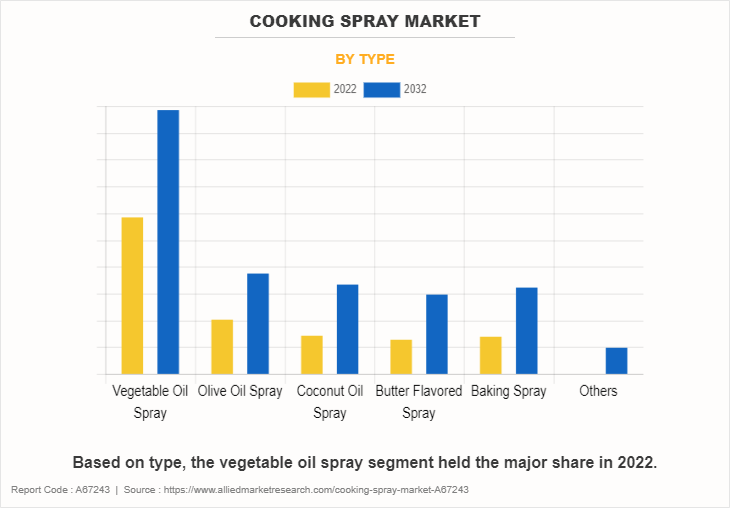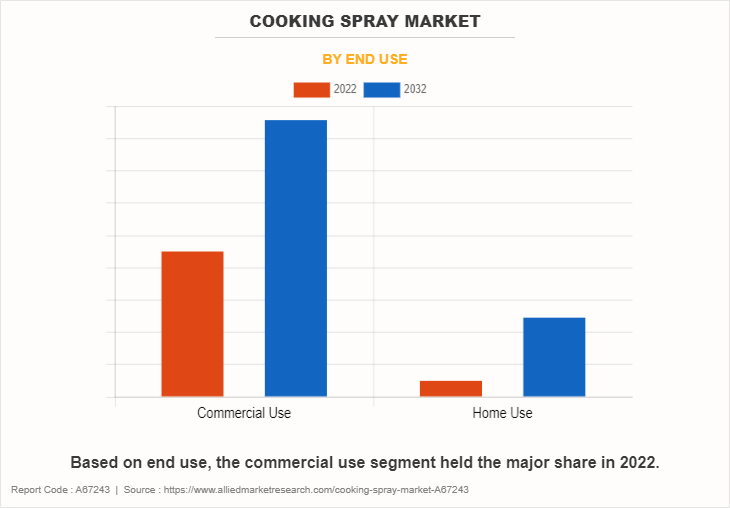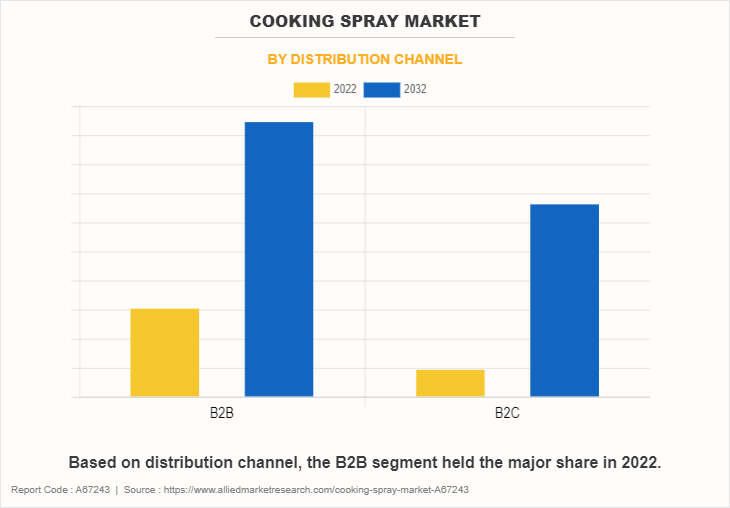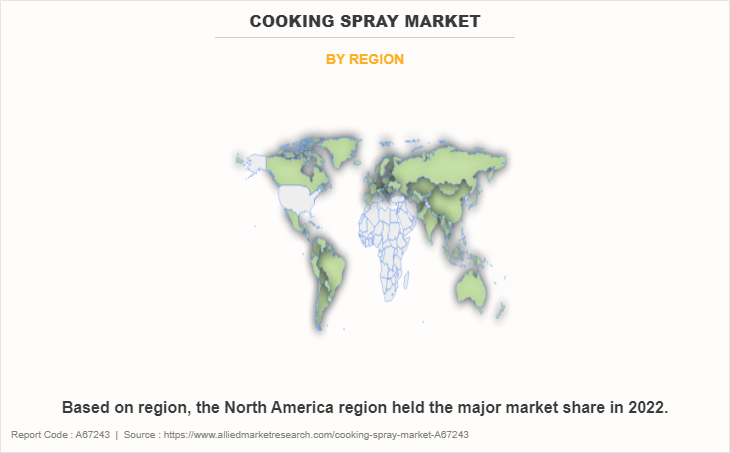Cooking Spray Market Research, 2032
The global cooking spray market size was valued at $9 billion in 2022, and is projected to reach $15 billion by 2032, growing at a CAGR of 5.4% from 2023 to 2032. Cooking spray is a convenient kitchen product used to grease cooking surfaces and prevent food from sticking during cooking or baking. It is typically sold in aerosol cans and contains a blend of oils, emulsifiers, and propellants. When sprayed onto pans, grills, or baking dishes, it forms a thin, even layer that helps food release easily without leaving a greasy residue. Cooking spray is available in various formulations, including options with added flavors or non-stick properties. It is popular for its ease of use, calorie-consciousness (as it can provide a lighter coating compared to traditional oils or butter), and versatility in different cooking methods.
Key Takeaways of Cooking Spray Market Report
- By End Use, the commercial use segment was the highest revenue contributor to the market in 2022, and is expected to grow at a significant CAGR during the forecast period.
- By type, the vegetable oil spray segment was the highest revenue contributor to the market in 2022, and is expected to grow at a significant CAGR during the forecast period.
- By Distriution Channel, the B2B segment was the highest revenue contributor to the market in 2022, and is expected to grow at a significant CAGR during the forecast period.
- By Region, the North America region was the highest revenue contributor to the market in 2022, and is expected to grow at a significant CAGR during the forecast period.
Market Dynamics
The Surge in Health Consciousness
The surge in health consciousness has significantly bolstered the demand for cooking spray industry. With an increasing focus on healthier eating habits, consumers are actively seeking alternatives to traditional oils and fats that offer reduced calorie content and fat intake. Cooking spray addresses these concerns by providing a lighter option for greasing cooking surfaces without compromising on flavor or cooking performance. This appeal to health-conscious consumers has led to a growing preference for cooking spray as a staple in kitchens worldwide. Moreover, cooking spray aligns with dietary trends promoting weight management and healthier cooking practices. Its ability to create a non-stick surface with minimal oil application resonates with individuals seeking to reduce their fat consumption while still enjoying their favorite dishes. As more people prioritize health and wellness in their lifestyles, the demand for cooking spray continues to rise, driving market growth. Manufacturers are responding to this trend by introducing innovative formulations and marketing strategies that highlight the health benefits of using cooking spray, further fueling its popularity among health-conscious consumers.
Convenience and Versatility
The surge in cooking spray market demand is largely driven by its inherent convenience. As consumers increasingly seek time-saving solutions in their busy lifestyles, cooking spray emerges as a convenient alternative to traditional oils and fats. Its easy-to-use aerosol packaging allows for quick and precise application, eliminating the need for measuring spoons or messy pouring. This convenience factor significantly reduces the time and effort required for food preparation, making it a desirable option for home cooks and professional chefs alike.
Moreover, the non-stick properties of cooking spray further enhance its convenience appeal. By preventing food from sticking to cooking surfaces, it streamlines the cooking process and simplifies cleanup, saving both time and water. This aspect is particularly appealing for individuals seeking efficient cooking solutions without compromising on taste or nutrition. The combination of these convenience factors not only drives the current demand for cooking spray but also positions it as a staple kitchen essential in modern households, contributing to sustained market growth.
The versatility of cooking spray plays a crucial role in surging market demand by catering to diverse culinary needs and preferences. Unlike traditional oils and fats, cooking spray can be used across a wide range of cooking methods, including frying, baking, grilling, and sautéing. This adaptability makes it a convenient option for consumers seeking simplicity and efficiency in their kitchen routines. Whether preparing breakfast pancakes, roasting vegetables, or grilling meats, cooking spray offers a non-stick solution that promotes healthier cooking with minimal cleanup, appealing to busy households and professional chefs alike.
In addition, the ability of cooking spray to provide a consistent and uniform coating on various cooking surfaces enhances its appeal. From coating baking pans to greasing grill grates, cooking spray ensures even distribution, preventing food from sticking and facilitating effortless release. This versatility not only saves time and effort but also promotes healthier cooking practices by reducing the need for excess oils and fats. As a result, the market demand for cooking spray continues to grow as consumers recognize its multifunctional benefits and integrate it into their everyday cooking routines.
The Non-Stick Properties of Cooking Spray
The non-stick properties of cooking spray significantly surge market demand by addressing a fundamental need in cooking: preventing food from sticking to cooking surfaces. This feature not only simplifies the cooking process but also enhances the overall cooking experience for consumers. By applying a thin, even layer of cooking spray to pans, grills, or baking dishes, users can effortlessly release food without leaving behind residue or requiring excessive oil. This convenience and ease of use resonate strongly with busy consumers seeking efficient solutions in their kitchen routines. Moreover, the non-stick nature of cooking spray aligns with contemporary health-conscious lifestyles. By requiring less oil for cooking, it promotes healthier food preparation, reducing overall calorie and fat intake. As consumers increasingly prioritize wellness and mindful eating, the appeal of cooking spray as a lighter alternative to traditional oils and fats grows. Consequently, the non-stick properties of cooking spray not only drive market demand but also position it as a versatile and indispensable kitchen staple for health-conscious individuals seeking convenience without compromising on taste or nutrition
Segmental Overview
The global cooking spray market is segmented into type, end use, distribution channel, and region. Based on type, the market is segmented into vegetable oil spray, olive oil spray, coconut oil spray, butter flavored spray, baking spray, and others. As per end use, the market is segmented into commercial use and personal use. Based on distribution channel, the market is segmented into hypermarket/supermarket, independent retail store, business to business, and online sales channel. Region wise, it is analyzed across North America, Europe, Asia-Pacific, LA, and MEA.
By Type
Based on type, the market is segmented into vegetable oil spray, olive oil spray, coconut oil spray, butter flavored spray, baking spray, and others. The vegetable oil spray segment accounted for a major share of the cooking spray market in 2022 and is expected to grow at a significant CAGR during the forecast period. The vegetable oil spray segment holds a major share in the cooking spray market due to several factors. Firstly, vegetable oil sprays are versatile and suitable for various cooking methods, including frying, baking, and grilling, making them widely applicable in different culinary scenarios. Additionally, vegetable oil sprays are perceived as a healthier option compared to some other types of cooking sprays, as they are often lower in saturated fats and may contain beneficial nutrients. This health-conscious appeal resonates with consumers seeking lighter cooking alternatives, contributing to the segment's dominance in the market.

By End User
Based on end use, the cooking spray market forecast is segmented into commercial use and personal use. The commercial use segment accounted for a major mcooking spray market share in 2022 and is expected to grow at a significant CAGR during the forecast period. The commercial use segment holds a significant share in the cooking spray market growth due to several factors. Firstly, commercial kitchens, including restaurants, cafes, and catering services, require large quantities of cooking spray for their daily operations, leading to high-volume purchases. Additionally, cooking sprays offer efficiency and convenience in these settings, reducing cooking time and labor costs. Moreover, businesses in the foodservice industry prioritize the use of cooking sprays for their non-stick properties, versatility across various cooking methods, and ability to enhance food presentation, contributing to the segment's dominance in the market.

By Distribution Channel
Based on distribution channel, the market is segmented into B2B and B2C. The B2B segment accounted for a major share of the cooking spray market in 2022 and is expected to grow at a significant CAGR during the forecast period. The B2B segment holds a major share in the cooking spray market due to its widespread use in the foodservice industry. Restaurants, hotels, catering businesses, and other food establishments rely on cooking sprays for their cooking needs on a large scale. Bulk purchasing of cooking sprays for commercial kitchens and food production facilities contributes significantly to the overall market share. Additionally, B2B customers often prioritize factors such as cost-effectiveness, quality, and consistency, driving demand for cooking sprays from manufacturers and distributors catering to this segment.

By Region
Based on region, it is analyzed across North America, Europe, Asia-Pacific, LA, and MEA. The North America region held the major market share in 2022, and is expected to grow at a significant CAGR during the forecast period. North America holds a major share in the cooking spray market primarily due to several factors. Firstly, the region has a high level of consumer awareness regarding health and wellness, driving the demand for healthier cooking alternatives like cooking sprays. Secondly, the prevalence of busy lifestyles encourages convenience-oriented cooking solutions, where cooking sprays offer a quick and easy way to prepare meals. Additionally, a well-established retail infrastructure, including supermarkets and online platforms, ensures widespread availability and accessibility of cooking spray products to consumers across North America.

Competitive Analysis
The major players operating in the market focus on key market strategies, such as mergers, product launches, acquisitions, collaborations, and partnerships. They have been also focusing on strengthening their market reach to maintain their goodwill in the ever-competitive market. Some of the key players in the global cooking spray market include Baker’s Joy, Crisco, Frylight, Mazola, PAM, Pompeian, Smart Balance, Spectrum, Vegalene, and Wesson.
Recent Developments in Cooking Spray Industry
In 2019, B&G Foods, a prominent producer and supplier of food and household items, completed the acquisition of Clabber Girl Corporation. Clabber Girl is known for manufacturing baking powder, corn starch, and various baking ingredients, along with cooking sprays.
Key Benefits for Stakeholders
- This report provides a quantitative analysis of the market segments, current trends, estimations, and dynamics of the cooking spray market analysis from 2022 to 2032 to identify the prevailing cooking spray market opportunities.
- The market research is offered along with information related to key drivers, restraints, and opportunities.
- Porter's five forces analysis highlights the potency of buyers and suppliers to enable stakeholders make profit-oriented business decisions and strengthen their supplier-buyer network.
- In-depth analysis of the cooking spray market segmentation assists to determine the prevailing market opportunities.
- Major countries in each region are mapped according to their revenue contribution to the global market.
- Market player positioning facilitates benchmarking and provides a clear understanding of the present position of the market players.
- The report includes the analysis of the regional as well as global cooking spray market trends, key players, market segments, application areas, and market growth strategies.
Cooking Spray Market Report Highlights
| Aspects | Details |
| Forecast period | 2022 - 2032 |
| Report Pages | 346 |
| By End Use |
|
| By Type |
|
| By Distribution Channel |
|
| By Region |
|
| Key Market Players | mazola, Crisco, pompeian, Vegalene, Smart Balance, PAM, Spectrum, Baker’s Joy, Frylight, Wesson |
Analyst Review
According to the insights of the CXOs, the global cooking spray market is expected to witness robust growth during the forecast period. This is attributed to cooking trends and professional endorsements. Cooking trends play a pivotal role in driving demand for cooking sprays as they adapt to evolving culinary practices. With the rise of healthier cooking methods like air frying and grilling, cooking sprays offer a convenient solution for achieving crispy textures without excess oil. Additionally, as more consumers embrace plant-based diets or seek alternatives to traditional cooking fats, cooking sprays provide a versatile option suitable for various dietary preferences. Their ease of use and ability to enhance flavor while reducing calories align with the growing demand for convenient yet health-conscious cooking solutions.
CXOs further added that, professional endorsements further bolster the market demand for cooking sprays by lending credibility and expertise to the product. When renowned chefs or nutritionists endorse cooking sprays as a preferred cooking fat, it validates their effectiveness and quality, instilling confidence in consumers. These endorsements often highlight the benefits of cooking sprays in achieving desirable cooking results while promoting healthier eating habits. As consumers trust the recommendations of culinary experts, they are more inclined to incorporate cooking sprays into their cooking routines, thus driving market growth through increased adoption and consumption.
The global cooking spray market size was valued at USD 9 billion in 2022, and is projected to reach USD 15 billion by 2032.
The global cooking spray market is projected to grow at a compound annual growth rate of 5.4% from 2023-2032 to reach USD 15 billion by 2032.
The key players profiled in the reports Vegalene, pompeian, PAM, Smart Balance, Crisco, Frylight, Spectrum, Wesson, mazola, Baker’s Joy.
North America dominated in 2022 and is projected to maintain its leading position throughout the forecast period.
The Surge in Health Consciousness, Convenience and Versatility, The Non-Stick Properties of Cooking Spray majorly contribute toward the growth of the market.
Loading Table Of Content...
Loading Research Methodology...



